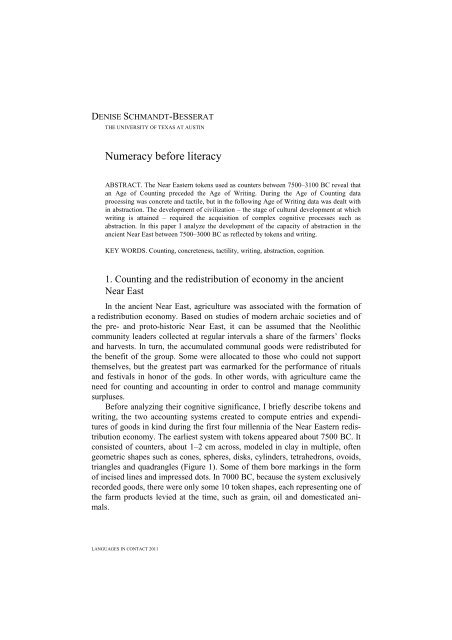s - Wyższa SzkoÅa Filologiczna we WrocÅawiu
s - Wyższa SzkoÅa Filologiczna we WrocÅawiu
s - Wyższa SzkoÅa Filologiczna we WrocÅawiu
Create successful ePaper yourself
Turn your PDF publications into a flip-book with our unique Google optimized e-Paper software.
DENISE SCHMANDT-BESSERAT<br />
THE UNIVERSITY OF TEXAS AT AUSTIN<br />
Numeracy before literacy<br />
ABSTRACT. The Near Eastern tokens used as counters bet<strong>we</strong>en 7500–3100 BC reveal that<br />
an Age of Counting preceded the Age of Writing. During the Age of Counting data<br />
processing was concrete and tactile, but in the following Age of Writing data was dealt with<br />
in abstraction. The development of civilization – the stage of cultural development at which<br />
writing is attained – required the acquisition of complex cognitive processes such as<br />
abstraction. In this paper I analyze the development of the capacity of abstraction in the<br />
ancient Near East bet<strong>we</strong>en 7500–3000 BC as reflected by tokens and writing.<br />
KEY WORDS. Counting, concreteness, tactility, writing, abstraction, cognition.<br />
1. Counting and the redistribution of economy in the ancient<br />
Near East<br />
In the ancient Near East, agriculture was associated with the formation of<br />
a redistribution economy. Based on studies of modern archaic societies and of<br />
the pre- and proto-historic Near East, it can be assumed that the Neolithic<br />
community leaders collected at regular intervals a share of the farmers’ flocks<br />
and harvests. In turn, the accumulated communal goods <strong>we</strong>re redistributed for<br />
the benefit of the group. Some <strong>we</strong>re allocated to those who could not support<br />
themselves, but the greatest part was earmarked for the performance of rituals<br />
and festivals in honor of the gods. In other words, with agriculture came the<br />
need for counting and accounting in order to control and manage community<br />
surpluses.<br />
Before analyzing their cognitive significance, I briefly describe tokens and<br />
writing, the two accounting systems created to compute entries and expenditures<br />
of goods in kind during the first four millennia of the Near Eastern redistribution<br />
economy. The earliest system with tokens appeared about 7500 BC. It<br />
consisted of counters, about 1–2 cm across, modeled in clay in multiple, often<br />
geometric shapes such as cones, spheres, disks, cylinders, tetrahedrons, ovoids,<br />
triangles and quadrangles (Figure 1). Some of them bore markings in the form<br />
of incised lines and impressed dots. In 7000 BC, because the system exclusively<br />
recorded goods, there <strong>we</strong>re only some 10 token shapes, each representing one of<br />
the farm products levied at the time, such as grain, oil and domesticated animals.<br />
LANGUAGES IN CONTACT 2011
















